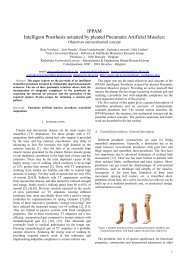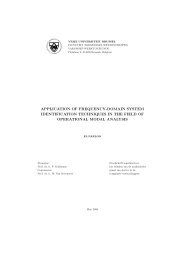VRIJE UNIVERSITEIT BRUSSEL Acoustics - the Dept. of ...
VRIJE UNIVERSITEIT BRUSSEL Acoustics - the Dept. of ...
VRIJE UNIVERSITEIT BRUSSEL Acoustics - the Dept. of ...
You also want an ePaper? Increase the reach of your titles
YUMPU automatically turns print PDFs into web optimized ePapers that Google loves.
50 CHAPTER 3. MEASURING SOUNDFor example, cars and airplanes that pass by repeatedly will not raise <strong>the</strong>average sound level L eq much but are annoying because <strong>of</strong> <strong>the</strong> repeated risingand fading away <strong>of</strong> sound. In o<strong>the</strong>r words, <strong>the</strong> frequent variation comparedto <strong>the</strong> background noise. Robinson proposed a measure: Noise PollutionLevel or N.P.L. : NPL = L eq +2.56σ. with L eq <strong>the</strong> energetic time averageas discussed above, and σ <strong>the</strong> standard deviation, that is to say, a statisticmeasure <strong>of</strong> <strong>the</strong> variations<strong>of</strong> <strong>the</strong> sound. The larger <strong>the</strong>se variations, <strong>the</strong> largerσ. There exists a very good correlation between <strong>the</strong> values obtained for NPLand <strong>the</strong> subjective nuisance <strong>of</strong> <strong>the</strong> fluctuating sound. For airplanes specialmodels exist. The noise loading is expressed as: L Amax +blogN +c, with N<strong>the</strong> number <strong>of</strong> flybys within a certain time interval, and a, b and c representconstants.3.9 The intensity meterIn Chapter 1 <strong>the</strong> notion sound intensity was introduced and it was shownthat <strong>the</strong> acoustic intensity I x in a direction x is given by : I x = v x p, where v xrepresents <strong>the</strong> particle speed <strong>of</strong> <strong>the</strong> sound wave in <strong>the</strong> x direction and p <strong>the</strong>sound pressure. The sound pressure can simply be measured with a microphone,but measuring <strong>the</strong> particle speed is far more difficult. This vectorialquantity can however be measured with <strong>the</strong> aid <strong>of</strong> a derived quantity :F x = ma⇒ ρ ∂v x∂t = −∂p ∂x⇒ v x = − 1 ∫ ∂pρ ∂xIn reality <strong>the</strong> derrivative <strong>of</strong> <strong>the</strong> pressure with respect to <strong>the</strong> distance is calculatedby discretization :I x = p.v x= − 12ρ∆r (p A +p B )∫(p A −p B )dtwhere p A and p B represent <strong>the</strong> sound pressure on two neighbouring locations.This discretized equation is used to calculate <strong>the</strong> sound intensity with <strong>the</strong>aid <strong>of</strong> <strong>the</strong> intensity meter (see Figure 3.15). This measuring device consists<strong>of</strong> two microphones spaced out over a fixed distance with a so called spacer(a few centimetres).The use <strong>of</strong> <strong>the</strong> intensity meter <strong>of</strong>fers some advantages :
















